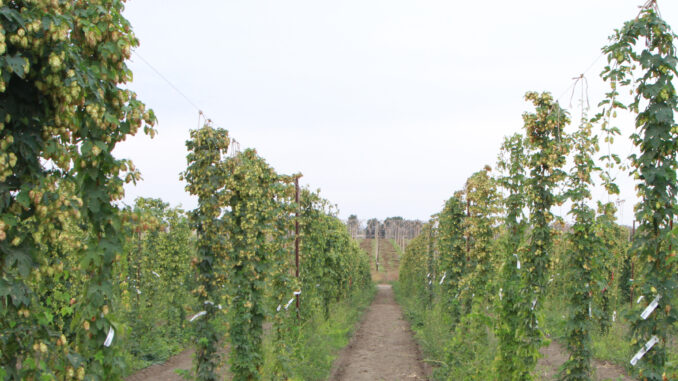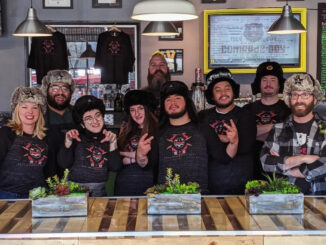
Depending on location and company size, it seems a mixed bag for the 2024 hop harvest for this fall. Getting insights from both the Pacific Northwest and Michigan, Brewer learned that weather, as always, will play into the harvest while communication for future harvests is key toward the success of hop growers and how the end user, breweries, can help adjust for what is to come.
“Contracting provides stability for all links in the supply chain for the consumer, the brewer, the merchant, and the farmer to have security to justify production costs,” explained Jonathan Blatchford, an Oregon Grower Representative for Hopsteiner.
As a smaller hop company, Brian Tennis, the founder of Hop Alliance in Michigan said they have never contracted with breweries in the company’s 17-year history, except with growers.
“We do have handshake agreements with our larger business partners, but we are far more flexible with the brewing community than most merchants,” Tennis said. “We get a sense of what the brewer needs are and we make sure they are covered without having to be heavy-handed and enforcing overly burdensome contracts.
“For our current business model, contracts simply do not work.”
BREWER: How did things go in getting your hop fields set up for 2024? Did anything surprising happen or did you plan anything new?
TENNIS: It’s been a very early start with optimal conditions so far. Very little mildew pressure. It seems to be the best start in the last 17 years.
BLATCHFORD: Very few growers would describe this spring as “business as usual.” As reported by Merchants at the US Hop Convention in January, there will be a significant reduction in productive hop acres across the northwest. For growers, this could mean idling yards that may come back into production in future years or removing hop plants and trellis altogether. This response to the market can also be seen in the new plantings for crop 2024.
BREWER: In your experience, how has what your area’s spring weather given you meant for the upcoming harvest season and what does that mean for 2024?
BLATCHFORD: The spring started off early and warmed up fast for Oregon and Washington; however, Idaho was much milder. After a long period of warm and dry weather, a cool and wet system moved through the area at the end of April/first part of May. This improved reservoir and snowpack conditions in Oregon and Idaho. Unfortunately, Washington did not benefit from these storms resulting in below-average snowpack. Conditions are warming up and plant growth is responding accordingly, most varieties are on track as the season transitions into early Summer.
TENNIS: The fact that we were able to get into the hopyard early and start spreading compost and addressing weed management, means we are set up perfectly for the start of the season. Stringing the hopyard was much easier this year because of the excellent weather conditions. No rain, snow, mud, or high winds to deal with. It’s too early to tell how this year’s crop will do, but we have the best start imaginable.
BREWER: How has what has been happening in craft beer helped set the tone for what you plan for and plant over these past few years and how are you changing what goes into the ground going forward?
TENNIS: We are in a different position than a lot of other merchants and farmers where we can leverage resources others don’t have, so we haven’t been impacted as badly as some other sectors of the business. We are more flexible in terms of what we can grow and sell and aren’t restricted to a handful of varieties. We carry nearly 80 hop varieties, half of which we currently grow and process here in Michigan. This allows us to spread our planting risk. With that said, we are seeing a shift back to more traditional hops and brewers are seeking more value than chasing the latest hop variety release. I think there have been far too many hops released in the past decade that had more hype than substance, so we are pulling back on planting and investing in unknown and untested hop varieties.
BLATCHFORD: The market is extremely challenging for brewers, merchants, and growers. Market corrections happen within business cycles, unfortunately, this may be a very challenging correction for a few years.
READ MORE: Inside Hop Harvest Selection Day
BREWER: Why do you feel it’s important for breweries to connect and share their plans on what they want to make and the hops they want to use in forecasting for your hop fields and acreage?
BLATCHFORD: This is very important for many varieties that aren’t as widely used as some of the standbys. Communication is always critical, especially so during challenging times. With the state of the industry in flux right now, if needs are not communicated, brewers will continue to be dependent on spot purchasing. Merchants cannot contract with growers for spot volumes. Eventually, spot hops may not be available, and brewers will be forced to adjust to what is available. Contracting, even at lesser and layered volumes will ensure availability for brewers in future years.
TENNIS: Hops take a few years to get established and up to 100% harvest rates here in Northern Michigan. We want to be able to sell mature and fully developed plants to brewers. You can taste and smell the difference between a first-year baby hop plant and a second or third-year plant. We need a good year’s notice from the brewer if they want a new variety planted or an increase in acreage for a current hop. This also holds true if they plan on phasing out the use of hop that we are growing. We don’t to be growing a hop that has no market. Luckily, we work very closely with brewers and can anticipate their needs. Constant communication is critical.






Be the first to comment